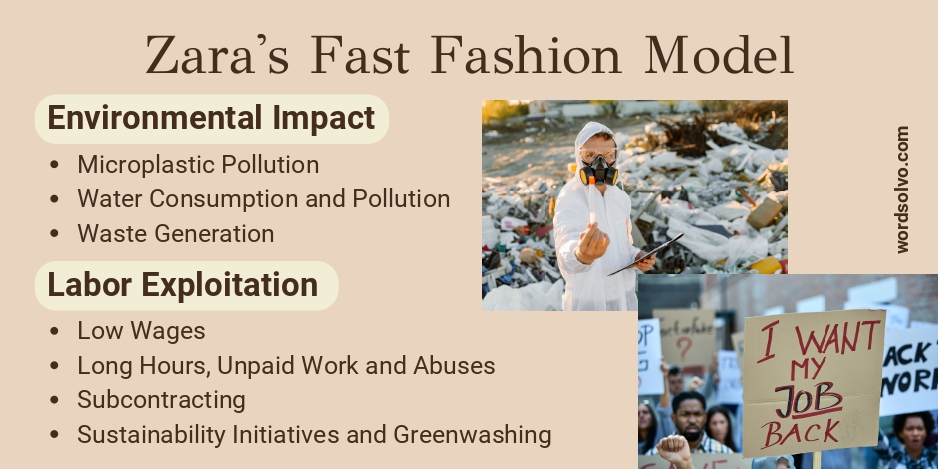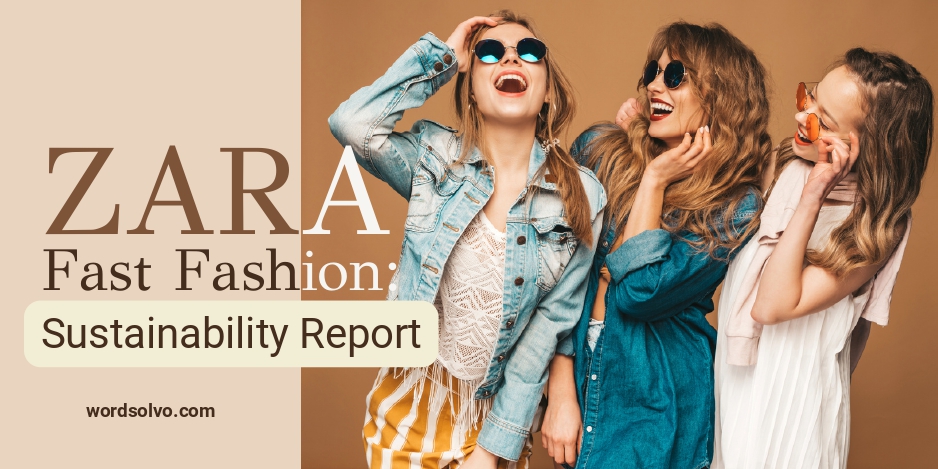1. Introduction
Zara, a prominent fast-fashion brand, has gained worldwide recognition for its trendy clothing and rapid turnover of styles. However, beneath its fashionable facade lie significant sustainability challenges that encompass environmental, ethical, and social dimensions. This report delves into Zara's fast fashion model, its impact on the environment and workers, the company's sustainability initiatives, and the prevalence of greenwashing. This Zara case study will help you craft your own report with valuable insights and links.
2. Zara's Fast Fashion Model
Zara's success hinges on its ability to swiftly translate runway trends into affordable garments on store shelves. This business model emphasises rapid production, low costs, and constant turnover of inventory. The brand's "fast fashion" approach has revolutionised the fashion industry but comes at a steep price for the environment and labour force.

2.1 Environmental Impact
Zara's fast fashion model contributes to several significant environmental problems:
2.1.1 Microplastic Pollution
The brand's frequent fabric turnover contributes to microplastic pollution in oceans, impacting marine life and ecosystems. Plants in countries like China have been found to pollute residential areas at levels far exceeding regulations, affecting local communities' health and well-being which increases Zara sustainability issues.
2.1.2 Water Consumption and Pollution
Zara's mass production consumes substantial amounts of water, while improper wastewater disposal pollutes water bodies. Zara uses viscose, a material derived from wood pulp. Viscose production, especially in countries like India, has led to water contamination and air pollution due to inadequate waste treatment.Zara's rapid production process leads to excessive water usage and energy consumption.The Global South, where many of Zara's factories are located, bears the brunt of the environmental and labour-related consequences. Zara's FY 2020 Statement on Non-Financial Information reveals little tangible information about the progress made in removing hazardous chemicals from the supply chain. This lack of transparency undermines the credibility of the brand's commitments which also increases Zara sustainability concerns.
2.1.3 Waste Generation
In 2012, Zara fast fashion pledged to eliminate hazardous chemicals from its operations by 2020. This commitment aimed to reduce the environmental impact of its production processes.However, the high rate of production results in excessive textile waste, contributing to overflowing landfills and emitting harmful greenhouse gases during decomposition.Zara produces over 800 million garments annually, raising questions about the effectiveness of sustainable material usage when such a large quantity of products contributes to waste generation.
2.2 Labor Exploitation
Zara's supply chain is marred by reports of unethical labour practices, including:
2.2.1 Low Wages
Workers in various countries endure low wages and substandard working conditions, often failing to meet living wage standards. Zara's 2020 Report prioritises the goal of paying living wages to workers, recognizing the importance of fair compensation for a sustainable supply chain.
2.2.2 Long Hours, Unpaid Work and Abuses
Factory employees, especially in countries with less stringent labour regulations, often face long work hours, unsafe conditions, and even instances of physical and verbal abuse. Reports have emerged of factory workers, particularly in facilities that are shut down, being left unpaid for their labour. Some even resorted to stuffing articles of Zara clothing with notes of protest. It has been reported that labourers in Tunisia are paid a meagre bonus for fulfilling impossible goals like producing 150 pieces of clothing in an hour. Ethical fashion advocates assert that Zara fast fashion business’ responsibility extends beyond disclaimers, urging the company to partner with ethical suppliers, ensure fair wages, and protect the rights of garment workers.
2.2.3 Subcontracting
Zara fast fashion has faced allegations of subcontracting production to factories that employ exploitative practices, resulting in unfair wages and unsafe work environments. Subcontracting production to factories that engage in exploitative practices, such as using migrant workers and teenagers in sweatshop-like conditions also contributes to Zara sustainability issues. The brand has distanced itself from these allegations by claiming it is not accountable for "unauthorised outsourcing," deflecting blame away from its role in the exploitation.
2.2.4 Sustainability Initiatives and Greenwashing
Zara's sustainability initiatives are commendable on paper but have faced scepticism due to a history of greenwashing. Ethical sourcing and responsible supplier partnerships are crucial to ensuring that Zara's sustainability efforts extend to the people in its supply chain. Given Zara's history of greenwashing, scepticism surrounds the extent to which these initiatives will be implemented and the genuine improvements that will be made.
3. Zara Sustainability Measures

3.1 Eco-Friendly Lines
Zara fast fashion introduced the "Join Life” line, aiming to promote sustainable textiles as part of the Zara sustainable goals. However, the brand's actual commitment to removing hazardous chemicals remains uncertain. The "Join Life" line is marketed as featuring eco-friendly fabrics, but the specific details of these textiles and their sustainable attributes are often not clearly communicated to consumers. Despite the introduction of this line as part of the Zara sustainable goals, concerns persist about the brand's commitment to removing hazardous chemicals from its operations. Transparency about progress and results is lacking, leaving uncertainty about the brand's actual dedication to this aspect of sustainability.
3.2 Emission Reduction Goals
Zara's commitment to transitioning to 100% renewable energy for internal operations by 2030 as part of the Zara sustainable goals reflects a positive step toward reducing its carbon footprint. Zara fast fashion’s plans to transition to renewable energy and reduce emissions are promising, but there's a concern that these pledges might be used as a form of greenwashing to distract from ongoing issues.
4. Conclusion
Zara's prominence as a fast-fashion giant is accompanied by a range of sustainability challenges. Zara's fast fashion model perpetuates environmental harm and labour exploitation. While the brand has announced sustainability initiatives, concerns over greenwashing persist. Given Zara's history of greenwashing and the fashion industry's reputation for superficial sustainability efforts, there's a need for transparent reporting and verification of emission reduction initiatives to ensure they are substantive rather than mere distractions from ongoing issues. As consumers become more aware of these issues, ethical alternatives gain traction, suggesting a growing demand for fashion that aligns with ethical and sustainable values.
This Zara case study can help you gain a clear understanding of what to include in your report on Zara sustainability. Please feel free to get in touch with us to get a customised and unique assignment report for your academic success.

